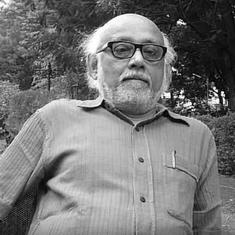Much of this growth will be in Asia, so the way Asian cities are designed, constructed and powered will clearly have a major influence on global efforts to moderate greenhouse gas emissions and diminish the impact of global warming.
With 8 million people crammed into what is an increasingly vertical space, Hong Kong is the evolving model for Asian urbanization. So it’s fitting that Hong Kong was the place where I and several fellow Nobel Laureates signed a memorandum endorsing the need for cities to take a central role in minimizing the harm caused by climate change.
How will cities do this, not just in Asia but right around the globe? Our Hong Kong meeting – the fourth Nobel Symposium on Global Sustainability, attended by Nobel Laureates, senior government officials, climatologists, behavioural scientists, engineers, architects, and business leaders from Hong Kong and mainland China – both defined the problem and discussed strategies.
Pollution and power
As climate scientists John Schellnhuber and Johan Rockstrom of the Potsdam Institute for Climate Impact Research (which co-hosted the meeting) pointed out, the first rule of capitalism is “don’t kill your customers.” But people in cities are already dying from respiratory disease. Anyone who has visited an Asian city will understand that this is a consequence of massive air pollution.
While the browny-grey clouds of particulate pollution that hang over these cities partially blot out the Sun and have a cooling effect, the sources that generate it – largely coal and automobile exhausts – also release greenhouse gases that raise temperatures in the longer term. Successive speakers at the symposium made it very obvious that China is determined to cut its coal use, fast.
Hong Kong itself currently generates half of its electricity from coal (see figure 6 here) and, according to local executive Christine Loh, will cut that to 20% by 2020. China has famously pledged to peak its total greenhouse emissions by 2030 and Jiang Kejun of China’s Energy Research Institute emphasized that the aim is to source 70% of its electricity from renewables by 2050, if not long before.
That has to happen. Apart from the human costs, Nobel-winning economist Jim Mirrlees estimates that China’s GDP will fall dramatically if CO2 emissions continue unchecked. And China, with its focus on solar and wind technology plus the new China Development Bank, will be doing the “right thing” (both globally and in its own self interest) by supporting the dissemination of renewable energy in emerging economies. Apart from being on the wrong side of history, any argument that selling coal is likely to drive the economies of the future seems unrealistic.
The rising tide of action
A major concern for big coastal cities is, of course, sea-level rise. With storm surges, an increase of only 15 cm will evidently inundate much of Bangkok, while China’s low-lying, heavily industrialised Pearl River Delta – home to several megacities, including Hong Kong – is also very vulnerable to flooding. Then Nobel-winning chemist and director of Japan’s RIKEN research institute, Ryoji Nyori, told the symposium that of the 34 million people in the greater Tokyo area, 15 million are at acute risk of ocean and river flooding.
The buildings and even the streets will need to be smart, too. Hong Kong architect Peter Cookson-Smith discussed underground water storage for cities and described how skyscraper foundations can serve as hybrid ventilation and heating/cooling systems. Meanwhile Roger Dennis, who leads the Sensing City Project in Christchurch, pointed out how building such technology into structures, pavements and the like can be used to moderate energy usage.
At a more direct level, Dennis described how Los Angeles has achieved a 63% cut in its lighting bill simply by switching to LED streetlights. An image of a light pole topped with a solar collector and a small wind generator illustrated how cities might also use their streetlights to generate power. All such micro-generation techniques will be made easier with the advent of affordable storage systems, like that recently unveiled by Tesla, or the new vanadium redox flow battery developed at the University of New South Wales.
From Canberra, ACT Labor MP Simon Corbell described how, using a high feed-in tariff (reimbursement of people generating power from solar on their roof) Australia’s capital is driving rapidly towards its 90% renewable energy target. Meanwhile, Copenhagen’s Mayor of Technical and Environmental Affairs, Morten Kabell, told us that his city is well on its way to being carbon-neutral by 2025, is already heating and cooling itself using highly efficient central facilities and has 45% of its commuting population on bicycles. Top priority for snow clearing goes to the greatly enhanced system of bike lanes!
Far-sighted vision
Cities are dynamic places, and as such their politicians can afford to be adventurous. Frustrated with the inaction of national governments in thrall to vested interests, New York-based political theorist Benjamin Barber is doing his utmost to establish a Global Parliament of Mayors, which will meet for the first time in Britain in October.
Embracing ambitious ideas will inevitably help innovative cities stay at the forefront of moves to decrease energy costs and clean up the atmosphere. For instance, Columbia and LSE academic Saskia Sassen suggested that every surface in the emerging global city should be have an environmental function. What did she mean? Solar energy generation, “living” green walls, passive heating and cooling, or other applications that may as yet be just a flash of barely perceived insight in some innovator’s mind?
For all this to happen, the world will need to witness a Third Industrial Revolution, focused on (and by) intensive, interactive urban environments and driven by a spectrum of innovators working in industry, government and, as Schellnhuber suggested, in “100,000 laboratories” – which, in a sense, include the expanding cities of our planet.
Clearly this massive transition is both an enormous challenge and offers incredible economic opportunities that, delivered by Asia’s burgeoning megacities, are right in Australia’s neighbourhood. As always, the future belongs to those with the courage to embrace it, while the fearful who turn resolutely to the past set us all up for disaster. Australia’s cities can help too – we have both the creativity and the awareness; we just need to point ourselves in the right direction.
This article was originally published on The Conversation.










